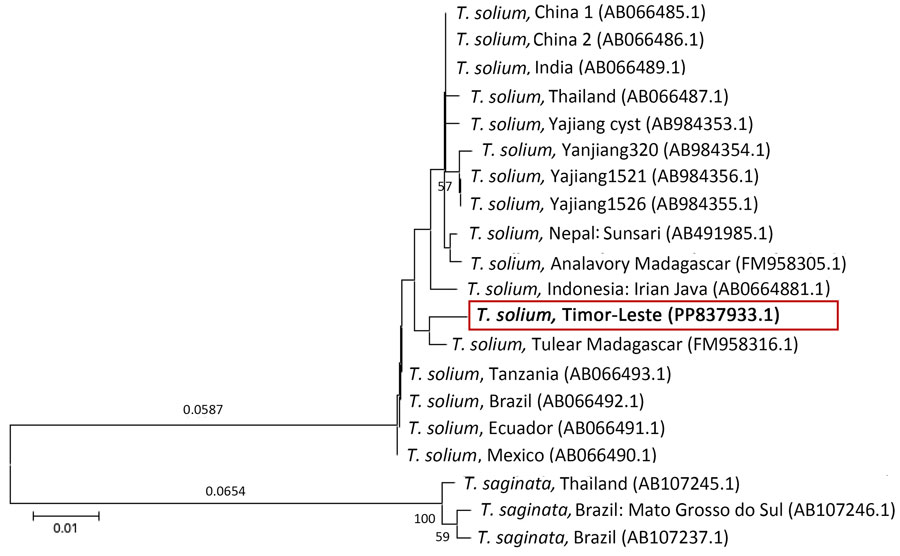Volume 30, Number 9—September 2024
Research Letter
Molecular Confirmation of Taenia solium Taeniasis in Child, Timor-Leste
Figure 2

Figure 2. Phylogenetic analysis of the cox-1 gene in case study of Taenia solium taeniasis in a child, Timor-Leste. Evolutionary history was inferred by using the neighbor-joining method and analysis was conducted by using MEGA11 (4). Red box and bold text indicates the sequence from this study. GenBank accession numbers are indicated in parentheses. Percentages of replicate trees in which the associated taxa clustered together in the bootstrap test (1,000 replicates) are shown below the branches. Tree is drawn to scale; branch lengths (above the branches) are in the same units as those of the evolutionary distances used to infer the phylogenetic tree. The evolutionary distances were computed by using the Kimura 2–parameter method. Analysis involved 20-nt sequences. Codon positions included were first + second + third + noncoding. All ambiguous positions were removed for each sequence pair (pairwise deletion option). A total of 480 positions were in the final dataset. Scale bar indicates nucleotide substitutions per site.
References
- World Health Organization. WHO guidelines on management of Taenia solium neurocysticercosis. 2021 [cited 2024 Apr 17]. https://www.who.int/publications/i/item/9789240032231
- Wu HW, Ito A, Ai L, Zhou XN, Acosta LP, Lee Willingham A III. Cysticercosis/taeniasis endemicity in Southeast Asia: Current status and control measures. Acta Trop. 2017;165:121–32. DOIPubMedGoogle Scholar
- Cho J, Jung BK, Lim H, Kim MJ, Yooyen T, Lee D, et al. Four cases of Taenia saginata infection with an analysis of COX1 gene. Korean J Parasitol. 2014;52:79–83. DOIPubMedGoogle Scholar
- Tamura K, Stecher G, Kumar S. MEGA11: molecular evolutionary genetics analysis version 11. Mol Biol Evol. 2021;38:3022–7. DOIPubMedGoogle Scholar
- Michelet L, Carod JF, Rakontondrazaka M, Ma L, Gay F, Dauga C. The pig tapeworm Taenia solium, the cause of cysticercosis: Biogeographic (temporal and spacial) origins in Madagascar. Mol Phylogenet Evol. 2010;55:744–50. DOIPubMedGoogle Scholar
- Ito A, Wandra T, Li T, Dekumyoy P, Nkouawa A, Okamoto M, et al. The present situation of human taeniases and cysticercosis in Asia. Recent Pat Antiinfect Drug Discov. 2014;9:173–85. DOIPubMedGoogle Scholar
- Walker J, Chen S, Packham D, McIntyre P. Five cases of neurocysticercosis diagnosed in Sydney. Southeast Asian J Trop Med Public Health. 1991;22(Suppl):242–4.PubMedGoogle Scholar
- Susilawathi NM, Suryapraba AA, Soejitno A, Asih MW, Swastika K, Wandra T, et al. Neurocysticercosis cases identified at Sanglah Hospital, Bali, Indonesia from 2014 to 2018. Acta Trop. 2020;201:
105208 . DOIPubMedGoogle Scholar - Smyth J, Adams V, Napier S. Case report: Getting it taped. Br Dent J. 2015;219:146. DOIPubMedGoogle Scholar
- Australian Centre for International Agricultural Research. Evaluating the opportunities for smallholder livestock keepers in Timor-Leste—final report [cited 2024 May 1]. https://www.aciar.gov.au/publication/LS-2017-035-final-report